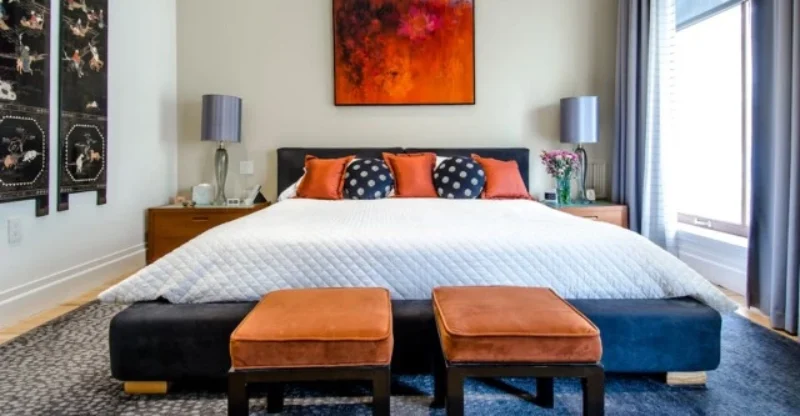How to Design a Room With These 9-Simple Steps
Designing a room is an exciting journey that allows you to express your style and create a space that’s truly your own.
Whether you’re looking to design a master bedroom that serves as a peaceful sanctuary, a lively and welcoming living room, or a productive and inspiring home office, the process involves creativity, careful planning, and a keen eye for detail.
The task might initially seem daunting, especially when starting from scratch. However, with the right approach, you can navigate this process smoothly. This guide walks you through designing a room, from the initial planning phase to the final touches.
1. Identify Your Style and Get Inspired
Before moving furniture or painting walls, it’s essential to identify your style. Are you drawn to modern, minimalist designs or prefer a more rustic, cozy feel?
Spend time browsing home decor magazines, exploring design websites, or scrolling through Pinterest to gather inspiration.
You’ll notice common themes and elements that resonate with you as you do. Use these insights to create a mood board, a visual tool to help you define your style and plan your room design.
2. Understand Your Space
Next, look at the room you’re planning to design. Measure the room’s dimensions, noting the location of doors, windows, and any built-in features like fireplaces or shelves.
Consider the room’s purpose: is it a master bedroom where you’ll relax and unwind or a living room where you’ll entertain guests? The function of the room will significantly influence your design decisions.
3. Plan Your Space
Once you clearly understand your room, it’s time to create a floor plan. You can use design software or sketch it out on graph paper.
Your floor plan should include all the significant pieces of furniture you plan to include. Remember to consider traffic flow in the room; you want to ensure enough space to move around comfortably.
Note: This website is supported by readers and if you click on our links we may earn a commission and as an Amazon Associate, we earn from qualifying purchases.
4. Create a Budget
Designing a room can quickly become expensive if you don’t plan. Before you start buying paint or furniture, decide on a budget for your project.
Consider what items you need to purchase and prioritize your spending. For example, you may invest in high-quality furniture like a bed or sofa and save on accessories or decor items.
Remember, a beautiful room design doesn’t have to break the bank. With careful planning and smart shopping, you can create a space that looks like a million bucks without spending a lot of money.
5. Choose Your Color Palette
The colors you choose for your room can significantly impact the overall mood and feel of the space. If you want a calming, serene bedroom, consider soft blues or greens.
Are you looking to create a vibrant, energetic living room? Brighter colors like yellows or oranges might be the way to go.
You can draw inspiration for your color palette from various sources, including your mood board, a favorite piece of art, or even nature.
Once you’ve chosen your color scheme, you can use it to guide your choices for paint color, furniture, and accessories.
6. Select Your Furniture
Now that you have a plan and a color scheme, it’s time to choose your furniture. Start with the larger pieces, like beds, sofas, or coffee tables.
These pieces will serve as the anchors for your room and set the tone for the rest of the space.
When selecting furniture, consider the style, color, and scale. A piece of furniture that is too large can overwhelm a room, while one that is too small can make the space feel out of balance.
Once you’ve chosen your large pieces, you can start adding smaller pieces like side tables, chairs, or bookshelves.
7. Lighting and Finishes
Lighting plays a crucial role in setting the mood of a room. A well-lit room feels warm and inviting, while a poorly lit room can feel cold and uninviting.
Start by considering the natural light in your room. How much natural light does the room get, and at what times of the day?
Next, think about where you need additional lighting. Task lighting for reading or working, ambient lighting for general illumination, and accent lighting to highlight artwork or architectural features.
When it comes to finishes, consider your room’s existing features. If you’re starting from scratch, you could add new finishes like hardwood floors or a fresh coat of paint.
If you’re redesigning an existing room, consider how you can build on the room’s existing features. For example, you could refinish hardwood floors or add a fresh paint coat to brighten the space.
8. Accessorize Your Room
Accessories are the finishing touches that make a room feel complete. They add personality and character to your space, making it feel like home.
Consider adding personal touches like family photos, artwork, or travel souvenirs. Throw pillows and rugs can add color and texture to your room, while lamps and candles create a cozy, warm atmosphere.
Remember, the goal is to create a space that reflects your style and feels comfortable.
9. Execution and Refinement
Now that you have a plan, it’s time to bring your room design to life. Start by preparing the room – this might involve painting the walls, installing new flooring, or moving furniture.
As you implement your design, don’t be afraid to make adjustments. Something may not work as well in reality as it did in your plan, and that’s okay.
Designing a room is a process, and making changes along the way is okay. Keep refining your design until you’re happy with the result.
Conclusion
Designing a room from scratch might seem daunting, but it can be an enjoyable and rewarding experience with careful planning and a step-by-step approach. Start by identifying your style and gathering inspiration, then understand your space and create a floor plan.
Set a budget to guide your spending, choose a color palette that sets the right mood, and select furniture that fits your space and style.
Remember, the goal is not to create a perfect room but a space that feels like home, a space that reflects your style and serves its function well.
So whether you’re designing a master bedroom, a cozy living room, or any other space in your home, enjoy the process and make it yours.



